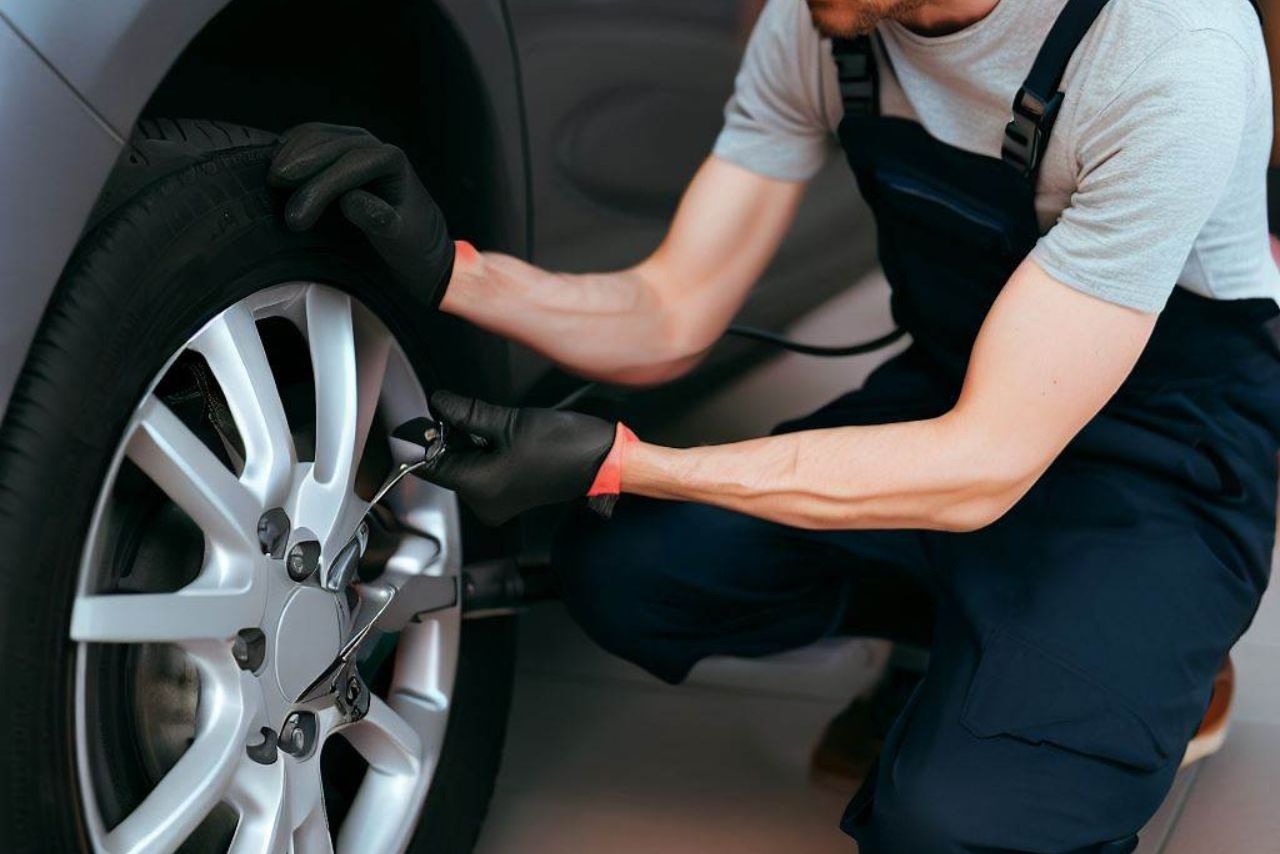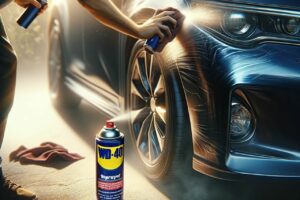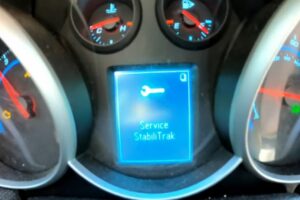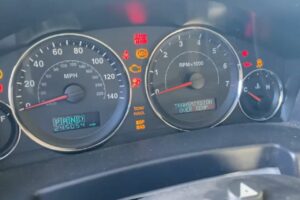If you’re a proud owner of a Ford Fiesta, it’s important to keep your tyres at the correct pressure for optimal performance and safety.
Knowing the recommended Ford Fiesta Tyre Pressures can be found on the placard located on the driver or passenger door opening or under the fuel/charging cap.
If you’re unsure, refer to your vehicle handbook for the correct air pressure listing.
Tyre pressure can vary depending on the size of your tyres and the weight of your load, and it’s crucial to maintain the proper pressure to ensure your vehicle performs at its best.
This article will provide a comprehensive guide to the recommended tyre pressures for various tyre sizes of the Ford Fiesta, as well as additional information on tyre care and maintenance.
So, buckle up and get ready to learn everything you need to know about keeping your Ford Fiesta tyres in top shape!
Table of contents
What Should My Tyre Pressure Be Ford Fiesta?
The recommended tyre pressure for a Ford Fiesta varies depending on the model and year.
It is best to refer to the owner’s manual or the tyre placard located on the driver’s side door jamb for the recommended tyre pressure for your specific vehicle.
In general, the recommended tyre pressure for a Ford Fiesta ranges from 29 to 35 psi (pounds per square inch).
Make sure to check the placard on your driver or passenger door opening or under your fuel/charging cap, or refer to your vehicle handbook for the correct air pressure listing depending on your tyre size and loading.
Maintaining the right tyre pressure can also protect your tyres from wear and tear. This is why it’s important to check your tyre pressure regularly and adjust it when needed.
Don’t underestimate the importance of maintenance when it comes to your tyres. It can save you money in the long run and ensure that your Ford Fiesta is always ready for the road.
Ford Fiesta Tyre Pressure Variations:
| Tyre Size | Front (Unloaded) | Front (Loaded) | Rear (Unloaded) | Rear (Loaded) |
|---|---|---|---|---|
| 175/65 R14 82T | 30 psi | 33 psi | 26 psi | 29 psi |
| 195/45 R16 80V | 30 psi | 33 psi | 29 psi | 32 psi |
| 195/50 R15 82H | 29 psi | 32 psi | 26 psi | 29 psi |
| 195/55 R15 85T | 30 psi | 33 psi | 26 psi | 29 psi |
| 205/40 R17 84W XL | 36 psi | 39 psi | 26 psi | 31 psi |
| 205/45 R16 84V XL | 36 psi | 39 psi | 26 psi | 31 psi |
| 205/50 R17 89V XL | 39 psi | 42 psi | 28 psi | 31 psi |
To ensure optimal performance and safety while driving, it’s important that you are aware of the varying tyre pressures based on the size and loading of your vehicle’s tyres.
Underinflated tyres can cause increased rolling resistance, leading to reduced fuel efficiency and increased tyre wear. It can also result in poor handling, longer stopping distances, and increased risk of blowouts.
Overinflated tyres, on the other hand, can cause the vehicle to bounce and may lead to a loss of traction, resulting in reduced control of the vehicle and increased risk of accidents.

Maintaining the correct tyre pressure has several benefits, including improved fuel efficiency, better handling, and increased tyre life.
Properly inflated tyres can also reduce the risk of accidents, as they provide better traction and stability on the road.
It’s important to note that the recommended tyre pressure listed in your vehicle handbook or on the placard may differ depending on the size and loading of your tyres.
By regularly checking and maintaining the correct tyre pressure, you can ensure optimal performance and safety while driving.
Ford Fiesta Tyre Size and Loading:
| Tyre Size | Load Index | Speed Rating | Max Load (Front) | Max Load (Rear) |
|---|---|---|---|---|
| 155/70/13 75 T | 480 kg | T | 300 kg | 345 kg |
| 175/65 R14 82 T | 500 kg | T | 325 kg | 370 kg |
| 195/45 R16 80 V | 525 kg | V | 350 kg | 385 kg |
| 195/50 R15 82 H | 540 kg | H | 360 kg | 395 kg |
| 195/55 R15 85 T | 575 kg | T | 380 kg | 415 kg |
| 205/40 R17 84 W XL | 615 kg | W | 425 kg | 460 kg |
| 205/45 R16 84 V XL | 630 kg | V | 435 kg | 470 kg |
| 205/50 R17 89 V XL | 660 kg | V | 450 kg | 485 kg |
Maintaining the proper air pressure for your vehicle’s tires can be a bit tricky, as it varies depending on the size and loading of the tires.
To ensure optimal inflation, it’s important to refer to the placard found on the driver/passenger door opening or under the fuel/charging cap.
If there’s no placard, you can refer to the vehicle handbook for the correct air pressure listing.

It’s crucial to note that over inflation or under inflation can have serious effects on your tires.
Over inflation effects can include a harsh ride, decreased traction and braking ability, and uneven wear on the center of the tire.
On the other hand, under inflation effects can include poor fuel efficiency, increased stopping distance, and excessive heat buildup which can lead to tire failure.
Additionally, it’s important to consider the load capacity of your tires. Overloading your vehicle can cause excessive wear and tear on your tires, leading to premature failure.
It’s also important to remember that temperature can impact your tire pressure, so it’s a good idea to check your tire pressure regularly, especially during extreme temperature changes.
How to Check Ford Fiesta Tire Pressure?
Make sure you know the correct air pressure for your specific vehicle, as checking your tire pressure regularly is essential to ensure optimal performance and safety on the road.
- To check your Ford Fiesta’s tire pressure, start by locating the placard on the driver/passenger door opening or under the fuel/charging cap. If you can’t find the placard, refer to your vehicle handbook for the correct air pressure listing.
- Once you have the correct inflation information, you can begin the checking procedure. You can use either digital gauges or manual gauges to measure tire pressure.
- Remember to check all four tires, including the spare, and check them when they are cold for the most accurate reading.
Regular maintenance of your tire pressure can help improve fuel efficiency, extend tire life, and ensure a smooth ride.
How Often Should You Check Tire Pressure?
Regularly checking the air pressure of your vehicle’s tires is crucial for maintaining optimal performance and safety on the road.
Here are some important things to keep in mind when it comes to checking the air pressure of your Ford Fiesta’s tires:
- It’s recommended that you check your tire pressure at least once a month, and before any long road trips.
- Extreme temperatures can cause your tire pressure to fluctuate, so it’s especially important to check your tires during temperature changes.
- As tires age, they can lose air pressure more quickly, so it’s important to check them more often as they get older.
Driving with low tire pressure can lead to decreased fuel efficiency, increased risk of accidents, and even tire blowouts.
On the other hand, properly inflated tires can improve fuel efficiency, increase tire life, and improve handling and safety on the road.
By following these guidelines and making sure your Ford Fiesta’s tires are properly inflated, you can help ensure a safer and more efficient driving experience. So don’t forget to check your tire pressure regularly!
How to Tell if Your Ford Fiesta Needs New Tires?
If you want to ensure a smooth and safe ride, it’s important to keep an eye out for signs of wear on your Ford Fiesta tires.
One of the most noticeable signs of wear is the tread depth. If the tread is worn down to 2/32 of an inch or less, it’s time to replace your tires.
You can check the tread depth by using a penny. Place the penny into the tread groove with Lincoln’s head upside down and facing you. If you can see the top of Lincoln’s head, the tread is too worn and needs to be replaced.
Another sign to look for is sidewall damage. If you notice cracks, cuts, bulges, or any other damage to the sidewall, it’s time to replace your tires. Sidewall damage can cause a blowout, which can be extremely dangerous while driving.
Alignment issues can also cause uneven wear on your tires. If you notice wear on one side of the tire, it’s important to get your alignment checked and corrected.
Regular tire rotation can help extend the life of your tires by ensuring even wear. It’s recommended to rotate your tires every 6,000 to 8,000 miles.
By keeping an eye out for these signs of wear and addressing them promptly, you can ensure a safe and smooth ride in your Ford Fiesta.
Should Tyre Pressure Be 30 or 32?
Now that you know how to tell if your Ford Fiesta needs new tires, let’s talk about tire pressure.

You might be wondering whether your tire pressure should be 30 or 32, but it depends on your specific tire size and loading.
It’s important to keep the correct tire pressure for your Ford Fiesta to ensure your safety on the road.
Driving with underinflated or overinflated tires can affect your vehicle’s handling, cause tire wear, and impact fuel efficiency.
Here are some pros and cons to keep in mind when it comes to tire pressure, as well as some safety concerns to consider:
- Pros: Properly inflated tires can improve fuel efficiency, increase tire lifespan, and provide better handling and control while driving.
- Cons: Overinflated tires can lead to a harsher ride, while underinflated tires can decrease fuel efficiency and cause premature tire wear.
- Safety concerns: Driving with incorrect tire pressure can affect your vehicle’s braking, acceleration, and handling, potentially leading to accidents.
- Weather impact: Extreme temperatures can cause tire pressure to fluctuate, so it’s important to check your tire pressure regularly, especially during temperature changes.
- Tire wear: Overinflated or underinflated tires can cause uneven tire wear, which can lead to the need for new tires sooner than expected.
To ensure your safety and the longevity of your tires, make sure to check your Ford Fiesta’s specific tire pressure and load requirements and adjust accordingly.
Frequently Asked Questions:
How do I know if my Ford Fiesta’s tyre pressure is too low or too high?
You can check your tyre pressure with a gauge and adjust if necessary. Low pressure can cause safety concerns and increase tyre wear, while high pressure can affect handling and be impacted by weather. Recommended brands include Michelin and Bridgestone. Checking frequency should be at least once a month.
Can I use a different tyre size than what is recommended for my Ford Fiesta?
Using different tyre sizes than recommended can impact performance and handling, and raise safety concerns. Compatibility concerns arise, so stick to recommended sizes for optimal safety and performance.
What is the average lifespan of a tyre for a Ford Fiesta?
The average lifespan of a tyre depends on your driving habits, road conditions, and weather effects. Look for wear indicators and replace them when they reach 2mm tread depth to ensure safety on the road.
How do I properly inflate my tyres for my Ford Fiesta?
To properly inflate your tyres, use a tyre gauge to check pressure at least once a month, and adjust to the recommended pressure listed in your vehicle handbook. Consider seasonal changes and monitor tyre wear indicators.
Are there any additional maintenance tips for my Ford Fiesta’s tyres besides checking the pressure regularly?
To maintain your tyres, ensure proper wheel alignment, regularly check tread depth, rotate tyres every 5,000-7,000 miles, and balance wheels. Choosing the right tyres for your driving needs is also important.
Conclusion and final thoughts 
So there you have it, the recommended tyre pressures for your Ford Fiesta, as well as some useful tips on tyre care and maintenance.
Remember, keeping your tyres at the correct pressure is essential for your safety on the road and optimal performance of your vehicle.
Make sure to check your tyre pressure regularly, especially before long journeys or when carrying heavy loads. And if you notice any signs of wear or damage on your tyres, it’s important to replace them as soon as possible.
With these simple steps, you can ensure that your Ford Fiesta’s tyres are in top condition and ready to take you wherever you need to go.
Latest Posts:
- Can WD-40 Remove Scratches on Cars? (Hint: Yes, but…)
- Can You Use a Drill to Polish Your Car? (We Tried it Out!)
- Should You Cover Car Scratches With Stickers? (REVEALED!)
- Buick Service Stabilitrak: (Causes & 100% Guaranteed Fix!)
- Common Holden Trax Problems (Causes & 100% Proven Fixes!)
- Jeep Commander Transmission Over Temp: (Guaranteed Fix!)











Leave a Reply